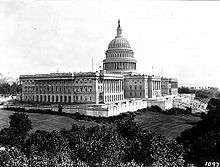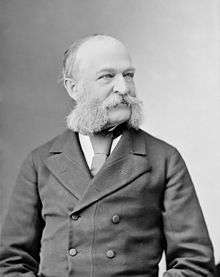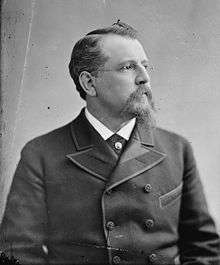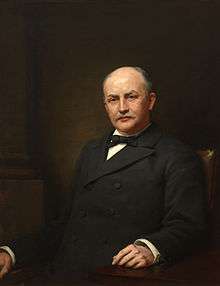52nd United States Congress
The 52nd United States Congress was a meeting of the legislative branch of the United States federal government, consisting of the United States Senate and the United States House of Representatives. It met in Washington, D.C. from March 4, 1891, to March 4, 1893, during the third and fourth years of Benjamin Harrison's presidency.
| 52nd United States Congress | |
|---|---|
51st ← → 53rd | |
 United States Capitol (1906) | |
| March 4, 1891 – March 4, 1893 | |
| Senate President | Levi P. Morton (R) |
| Senate President pro tem | Charles F. Manderson (R) |
| House Speaker | Charles F. Crisp (D) |
| Members | 88 senators 332 members of the House 4 non-voting delegates |
| Senate Majority | Republican |
| House Majority | Democratic |
| Sessions | |
| 1st: December 7, 1891 – August 5, 1892 2nd: December 5, 1892 – March 3, 1893 | |
The apportionment of seats in the House of Representatives was based on the Tenth Census of the United States in 1880. The Senate had a Republican majority, and the House had a Democratic majority.
Major events
Major legislation
Party summary
The count below identifies party affiliations at the beginning of the first session of this Congress, and includes members from vacancies and newly admitted states, when they were first seated. Changes resulting from subsequent replacements are shown below in the "Changes in membership" section.
Senate
| Party (shading shows control) |
Total | Vacant | |||||
|---|---|---|---|---|---|---|---|
| Democratic (D) |
Populist (P) | Independent (I) | Republican (R) | Other | |||
| End of previous congress | 35 | 0 | 0 | 51 | 0 | 86 | 2 |
| Begin | 36 | 1 | 1 | 46 | 0 | 84 | 4 |
| End | 39 | 47 | 88 | 0 | |||
| Final voting share | 44.3% | 1.1% | 1.1% | 53.4% | 0.0% | ||
| Beginning of next congress | 44 | 3 | 0 | 37 | 1[lower-alpha 1] | 85 | 3 |
House of Representatives
| Party (shading shows control) |
Total | Vacant | ||||
|---|---|---|---|---|---|---|
| Democratic (D) |
Populist (P) | Republican (R) | Other | |||
| End of previous congress | 153 | 0 | 176 | 1 | 330 | 2 |
| Begin | 236 | 9 | 87 | 0 | 332 | 0 |
| End | 233 | 86 | 328 | 4 | ||
| Final voting share | 71.0% | 2.7% | 26.2% | 0.0% | ||
| Beginning of next congress | 213 | 11 | 127 | 2[lower-alpha 2] | 353 | 3 |
Leadership

Levi P. Morton
Senate
- President: Levi P. Morton (R)
- President pro tempore: Charles F. Manderson (R)
- Republican Conference Chairman: John Sherman
- Democratic Caucus Chairman: Arthur P. Gorman
House of Representatives
- Speaker: Charles F. Crisp (D)
- Democratic Caucus Chairman: William S. Holman
- Republican Conference Chairman: Thomas J. Henderson
- Democratic Campaign Committee Chairman: Roswell P. Flower
Members
This list is arranged by chamber, then by state. Senators are listed by class, and Representatives are listed by district.
Senate
Senators were elected by the state legislatures every two years, with one-third beginning new six-year terms with each Congress. Senators are listed by Senate class numbers, which indicate the cycle of their election. In this Congress, Class 1 meant their term ended with this Congress, requiring re-election in 1892; Class 2 meant their term began in the last Congress, requiring re-election in 1894; and Class 3 meant their term began in this Congress, requiring re-election in 1896.
Alabama
Arkansas
California
Colorado
Connecticut
Delaware
Florida
Georgia
Idaho
Illinois
Indiana
Iowa
Kansas
Kentucky
Louisiana
Maine
Maryland
Massachusetts
Michigan
Minnesota
Mississippi
Missouri
Montana
|
Nebraska
Nevada
New Hampshire
New Jersey
New York
North Carolina
North Dakota
Ohio
Oregon
Pennsylvania
Rhode Island
South Carolina
South Dakota
Tennessee
Texas
Vermont
Virginia
Washington
West Virginia
Wisconsin
Wyoming
|
 President pro tempore Charles F. Manderson
|
House of Representatives
Members of the House of Representatives are preceded by their district numbers.
Changes in membership
The count below reflects changes from the beginning of this Congress.
Senate
- replacements: 7
- Democratic: no net change
- Republican: no net change
- Liberal Republican: 1 seat net loss
- deaths: 4
- resignations: 5
- interim appointments: 1
- Total seats with changes: 10
| State (class) |
Vacator | Reason for change | Successor | Date of successor's formal installation[lower-alpha 3] |
|---|---|---|---|---|
| California (1) |
Vacant | George Hearst died during previous congress. Successor was elected. |
Charles N. Felton (R) | March 19, 1891 |
| Maryland (3) |
Vacant | Ephraim K. Wilson died during previous congress. Successor was appointed and subsequently elected (January 21, 1892). |
Charles H. Gibson (D) | November 19, 1891 |
| New York (3) |
Vacant | Chose to finish his term as Governor of New York before being installed as U.S. Senator. | David B. Hill (D) | January 17, 1892 |
| Florida (3) |
Vacant | Legislature had failed to elect. Incumbent was elected late. |
Wilkinson Call (D) | May 26, 1891 |
| Texas (1) |
John H. Reagan (D) | Resigned June 10, 1891. Successor was appointed. |
Horace Chilton (D) | June 10, 1891 |
| Vermont (1) |
George F. Edmunds (R) | Resigned November 1, 1891. Successor was appointed and subsequently elected (October 19, 1892). |
Redfield Proctor (R) | November 2, 1891 |
| Kansas (2) |
Preston B. Plumb (R) | Died December 20, 1891. Successor was appointed. |
Bishop W. Perkins (R) | January 1, 1892 |
| Texas (1) |
Horace Chilton (D) | Successor was elected March 22, 1892. | Roger Q. Mills (D) | March 29, 1892 |
| Virginia (2) |
John S. Barbour Jr. (D) | Died May 14, 1892. Successor was appointed and subsequently elected (December 20, 1893). |
Eppa Hunton (D) | June 10, 1891 |
| Louisiana (2) |
Randall L. Gibson (D) | Died December 15, 1892. Successor was appointed and subsequently elected (May 23, 1894). |
Donelson Caffery (D) | December 31, 1892 |
| West Virginia (2) |
John E. Kenna (D) | Died January 11, 1893. Successor was elected. |
Johnson N. Camden (D) | January 25, 1893 |
| Kentucky (2) |
John G. Carlisle (D) | Resigned February 4, 1893, after being appointed United States Secretary of the Treasury. Successor was elected. |
William Lindsay (D) | February 15, 1893 |
House of Representatives
- replacements: 15
- Democratic: 1-seat net loss
- Republican: 1-seat net gain
- deaths: 10
- resignations: 8
- contested election: 1
- Total seats with changes: 18
| District | Vacator | Reason for change | Successor | Date successor seated |
|---|---|---|---|---|
| New York 10th | Francis B. Spinola (D) | Died April 14, 1891 | W. Bourke Cockran (D) | November 3, 1891 |
| Michigan 5th | Melbourne H. Ford (D) | Died April 20, 1891 | Charles E. Belknap (R) | November 3, 1891 |
| Tennessee 2nd | Leonidas C. Houk (R) | Died May 25, 1891 | John C. Houk (R) | December 7, 1891 |
| South Dakota At-large | John R. Gamble (R) | Died August 14, 1891 | John L. Jolley (R) | December 7, 1891 |
| New York 22nd | Leslie W. Russell (R) | Resigned September 11, 1891, after being elected judge for the New York Supreme Court | Newton M. Curtis (R) | November 3, 1891 |
| New York 12th | Roswell P. Flower (D) | Resigned September 16, 1891, to run for Governor of New York | Joseph J. Little (D) | November 3, 1891 |
| New York 2nd | David A. Boody (D) | Resigned October 13, 1891, to run for Mayor of Brooklyn, New York | Alfred C. Chapin (D) | November 3, 1891 |
| Virginia 8th | William H. F. Lee (D) | Died October 15, 1891 | Elisha E. Meredith (D) | December 9, 1891 |
| Pennsylvania 24th | Andrew Stewart (R) | Election was successfully challenged February 26, 1892 | Alexander K. Craig (D) | February 26, 1892 |
| Kentucky 10th | John W. Kendall (D) | Died March 7, 1892 | Joseph M. Kendall (D) | April 21, 1892 |
| California 3rd | Joseph McKenna (R) | Resigned March 28, 1892 | Samuel G. Hilborn (R) | December 5, 1892 |
| Texas 9th | Roger Q. Mills (D) | Resigned March 28, 1892, after being elected to the U.S. Senate | Edwin Le Roy Antony (D) | June 14, 1892 |
| South Carolina 6th | Eli T. Stackhouse (D) | Died June 14, 1892 | John L. McLaurin (D) | December 5, 1892 |
| Pennsylvania 24th | Alexander K. Craig (D) | Died July 29, 1892 | William A. Sipe (D) | December 5, 1892 |
| Ohio 16th | John G. Warwick (D) | Died August 14, 1892 | Lewis P. Ohliger (D) | December 5, 1892 |
| Maryland 1st | Henry Page (D) | Resigned September 3, 1892, to become judge for the Maryland Court of Appeals | John B. Brown (D) | November 8, 1892 |
| New Jersey 7th | Edward F. McDonald (D) | Died November 5, 1892 | Vacant until next Congress | |
| New York 2nd | Alfred C. Chapin (D) | Resigned November 16, 1892 | Vacant until next Congress | |
| Massachusetts 6th | Henry Cabot Lodge (R) | Resigned March 3, 1893, after being elected to the U.S. Senate | Vacant until next Congress | |
| Wisconsin 4th | John L. Mitchell (D) | Resigned March 3, 1893, after being elected to the U.S. Senate | Vacant until next Congress | |
Committees
Lists of committees and their party leaders, for members (House and Senate) of the committees and their assignments, go into the Official Congressional Directory at the bottom of the article and click on the link (4 links), in the directory after the pages of terms of service, you will see the committees of the Senate, House (Standing with Subcommittees, Select and Special) and Joint and after the committee pages, you will see the House/Senate committee assignments in the directory, on the committees section of the House and Senate in the Official Congressional Directory, the committee's members on the first row on the left side shows the chairman of the committee and on the right side shows the ranking member of the committee.
Senate
|
|
|
House of Representatives
- Accounts (Chairman: Harry Welles Rusk; Ranking Member: Albert J. Pearson)
- Agriculture (Chairman: William H. Hatch; Ranking Member: Charles L. Moses)
- Alcoholic Liquor Traffic (Select)
- Appropriations (Chairman: William S. Holman; Ranking Member: Joseph H. O'Neil)
- Banking and Currency (Chairman: Henry Bacon; Ranking Member: Seth W. Cobb)
- Claims (Chairman: Benjamin H. Bunn; Ranking Member: Isaac N. Cox)
- Coinage, Weights and Measures (Chairman: Richard P. Bland; Ranking Member: George F. Williams)
- Disposition of Executive Papers (Chairman: William E. Haynes; Ranking Member: Thomas Bowman)
- District of Columbia (Chairman: John J. Hemphill; Ranking Member: Cornelius A. Cadmus)
- Education (Chairman: Benjamin A. Enloe; Ranking Member: Edwin Hallowell)
- Elections (Chairman: Charles T. O'Ferrall; Ranking Member: George Johnstone)
- Enrolled Bills (Chairman: Owen Scott; Ranking Member: John A. Pickler)
- Expenditures in the Agriculture Department (Chairman: Paul C. Edmunds; Ranking Member: Kittel Halvorson)
- Expenditures in the Interior Department (Chairman: James W. Owens; Ranking Member: William W. Grout)
- Expenditures in the Justice Department (Chairman: John M. Allen; Ranking Member: Ezra B. Taylor)
- Expenditures in the Navy Department (Chairman: Charles A.O. McClellan; Ranking Member: George W. Ray)
- Expenditures in the Post Office Department (Chairman: William C. Oates; Ranking Member: James S. Gorman)
- Expenditures in the State Department (Chairman: Rufus E. Lester; Ranking Member: John Sanford)
- Expenditures in the Treasury Department (Chairman: George H. Brickner; Ranking Member: William A. Stone)
- Expenditures in the War Department (Chairman: Alexander B. Montgomery; Ranking Member: Robert R. Hitt)
- Expenditures on Public Buildings (Chairman: Henry M. Youmans; Ranking Member: John H. Ketcham)
- Foreign Affairs (Chairman: James H. Blount; Ranking Member: Isidor Rayner)
- Indian Affairs (Chairman: Samuel W. Peel; Ranking Member: Benjamin H. Clover)
- Interstate and Foreign Commerce (Chairman: George D. Wise; Ranking Member: Asher G. Caruth)
- Invalid Pensions (Chairman: Augustus N. Martin; Ranking Member: Edward F. McDonald then Walter H. Butler)
- Judiciary (Chairman: David B. Culberson; Ranking Member: Fernando C. Layton)
- Labor (Chairman: John C. Tarsney; Ranking Member: John W. Causey)
- Levees and Improvements of the Mississippi River (Chairman: Samuel M. Robertson; Ranking Member: William McAleer)
- Manufactures (Chairman: Charles H. Page; Ranking Member: Archibald H.A. Williams)
- Merchant Marine and Fisheries (Chairman: Samuel Fowler; Ranking Member: Herman Stump)
- Mileage (Chairman: James N. Castle; Ranking Member: John A. Caldwell)
- Military Affairs (Chairman: Joseph H. Outhwaite; Ranking Member: Edward F. McDonald then John C. Crosby)
- Militia (Chairman: Edward Lane; Ranking Member: Alexander K. Craig)
- Mines and Mining (Chairman: William H. H. Cowles; Ranking Member: Thomas Bowman)
- Naval Affairs (Chairman: Hilary A. Herbert; Ranking Member: William McAleer)
- Pacific Railroads (Chairman: James B. Reilly; Ranking Member: Frederick S. Coolidge)
- Patents (Chairman: George D. Tillman; Ranking Member: John T. Hamilton)
- Pensions (Chairman: Robert P.C. Wilson; Ranking Member: Charles L. Moses)
- Printing (Chairman: James D. Richardson; Ranking Member: Case Broderick)
- Private Land Claims (Chairman: Ashbel P. Fitch; Ranking Member: William T. Crawford)
- Post Office and Post Roads (Chairman: John S. Henderson; Ranking Member: John C. Crosby)
- Public Buildings and Grounds (Chairman: John H. Bankhead; Ranking Member: John De Witt Warner)
- Public Lands (Chairman: Thomas C. McRae; Ranking Member: Darius D. Hare)
- Railways and Canals (Chairman: Thomas C. Catchings; Ranking Member: Kittel Halvorson)
- Revision of Laws (Chairman: William T. Ellis; Ranking Member: Lemuel Amerman)
- Rivers and Harbors (Chairman: Newton C. Blanchard; Ranking Member: Charles H. Page)
- Rules (Chairman: Charles F. Crisp; Ranking Member: Thomas B. Reed)
- Standards of Official Conduct
- Territories (Chairman: Joseph E. Washington; Ranking Member: Dennis D. Donovan)
- War Claims (Chairman: Frank E. Beltzhoover; Ranking Member: George W. Shell)
- Ways and Means (Chairman: William M. Springer; Ranking Member: Moses T. Stevens)
- Whole
Joint committees
- Conditions of Indian Tribes (Special)
- Disposition of (Useless) Executive Papers
- The Library
- Printing
Caucuses
- Democratic (House)
- Democratic (Senate)
Employees
Legislative branch agency directors
Senate
- Chaplain: John G. Butler (Lutheran)
- Secretary: Anson G. McCook
- Librarian: Alonzo M. Church
- Sergeant at Arms: Edward K. Valentine
House of Representatives
- Clerk: Edward McPherson, until December 8, 1891
- James Kerr, from December 8, 1891
- Clerk at the Speaker's Table: Charles R. Crisp
- Chaplain: William H. Milburn (Methodist)
- Doorkeeper: Charles H. Turner, elected December 8, 1891
- Reading Clerks: John A. Reeve (D) and James C. Broadwell (R)
- Postmaster: James W. Hathaway
- Sergeant at Arms: Adoniram J. Holmes, until December 8, 1891
- Samuel S. Yoder, from December 8, 1891
See also
- United States elections, 1890 (elections leading to this Congress)
- United States Senate elections, 1890
- United States House of Representatives elections, 1890
- United States elections, 1892 (elections during this Congress, leading to the next Congress)
- 1892 United States presidential election
- United States Senate elections, 1892
- United States House of Representatives elections, 1892
Notes
References
- Martis, Kenneth C. (1989). The Historical Atlas of Political Parties in the United States Congress. New York: Macmillan Publishing Company.
- Martis, Kenneth C. (1982). The Historical Atlas of United States Congressional Districts. New York: Macmillan Publishing Company.
External links
- Biographical Directory of the U.S. Congress
- U.S. House of Representatives: House History
- U.S. Senate: Statistics and Lists
- Official Congressional Directory for the 52nd Congress, 1st Session.
- Official Congressional Directory for the 52nd Congress, 1st Session (1st Revision).
- Official Congressional Directory for the 52nd Congress, 1st Session (2nd Revision).
- Official Congressional Directory for the 52nd Congress, 2nd Session.
- Official Congressional Directory for the 52nd Congress, 2nd Session (Revision).

